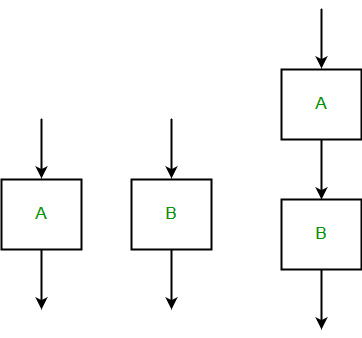Software Engineering
Question 1
Match the problem domains in GROUP I with the solution technologies in GROUP II
GROUP I GROUP II (P) Service oriented computing (1) Interoperability (Q) Heterogeneous communicating systems (2) BPMN (R) Information representation (3) Publish-find-bind (S) Process description (4) XML
Question 2
The following figure represents access graphs of two modules M1 and M2. The filled circles represent methods and the unfilled circles represent attributes. If method m is moved to module M2 keeping the attributes where they are, what can we say about the average cohesion and coupling between modules in the system of two modules?


Question 3
A company needs to develop a strategy for software product development for which it has a choice of two programming languages L1 and L2. The number of lines of code (LOC) developed using L2 is estimated to be twice the LOC developed with Ll. The product will have to be maintained for five years. Various parameters for the company are given in the table below.
Total cost of the project includes cost of development and maintenance. What is the LOC for L1 for which the cost of the project using L1 is equal to the cost of the project using L2?
| Parameter | Language L1 | Language L2 |
| Man years needed for development | LOC/10000 | LOC/10000 |
| Development cost per man year | Rs. 10,00,000 | Rs. 7,50,000 |
| Maintenance time | 5 years | 5 years |
| Cost of maintenance per year | Rs. 1,00,000 | Rs. 50,000 |
Question 4
A company needs to develop digital signal processing software for one of its newest inventions. The software is expected to have 40000 lines of code. The company needs to determine the effort in person-months needed to develop this software using the basic COCOMO model. The multiplicative factor for this model is given as 2.8 for the software development on embedded systems, while the exponentiation factor is given as 1.20. What is the estimated effort in person-months?
Question 5
Which one of the following is NOT desired in a good Software Requirement Specifications (SRS) document?
Question 6
The following is the comment written for a C function.
/* This function computes the roots of a quadratic equation
a.x^2 + b.x + c = . The function stores two real roots
in *root1 and *root2 and returns the status of validity
of roots. It handles four different kinds of cases.
(i) When coefficient a is zero irrespective of discriminant
(ii) When discriminant is positive
(iii) When discriminant is zero
(iv) When discriminant is negative.
Only in case (ii) and (iii) the stored roots are valid.
Otherwise 0 is stored in roots. The function returns
0 when the roots are valid and -1 otherwise.
The function also ensures root1 >= root2
int get_QuadRoots( float a, float b, float c,
float *root1, float *root2);
*/
A software test engineer is assigned the job of doing black box testing. He comes up with the following test cases, many of which are redundant.
[caption width="800"] [/caption]
[/caption]
Which one of the following option provide the set of non-redundant tests using equivalence class partitioning approach from input perspective for black box testing?
Question 7
Question 8
What is the appropriate pairing of items in the two columns listing various activities encountered in a software life cycle?
P. Requirements Capture 1.Module Development and Integration Q. Design 2.Domain Analysis R. Implementation 3.Structural and Behavioral Modeling S. Maintenance 4.Performance Tuning
Question 9
The following program is to be tested for statement coverage:
begin
if (a== b) {S1; exit;}
else if (c== d) {S2;]
else {S3; exit;}
S4;
end
The test cases T1, T2, T3 and T4 given below are expressed in terms of the properties satisfied by the values of variables a, b, c and d. The exact values are not given.
T1 : a, b, c and d are all equal
T2 : a, b, c and d are all distinct
T3 : a = b and c != d
T4 : a != b and c = d
Which of the test suites given below ensures coverage of statements S1, S2, S3 and S4?
Question 10
The coupling between different modules of a software is categorized as follows:
I. Content coupling II. Common coupling III. Control coupling IV. Stamp coupling V. Data coupling
Coupling between modules can be ranked in the order of strongest (least desirable) to weakest (most desirable) as follows:
There are 162 questions to complete.
Last Updated :
Take a part in the ongoing discussion
